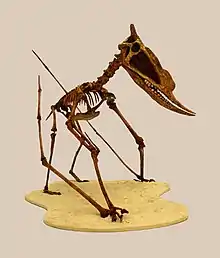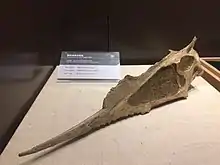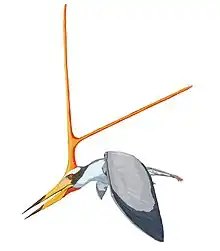| Dsungaripterus Temporal range: Early Cretaceous, | |
|---|---|
 | |
| Reconstructed skeleton | |
| Scientific classification | |
| Domain: | Eukaryota |
| Kingdom: | Animalia |
| Phylum: | Chordata |
| Order: | †Pterosauria |
| Suborder: | †Pterodactyloidea |
| Family: | †Dsungaripteridae |
| Subfamily: | †Dsungaripterinae |
| Genus: | †Dsungaripterus Young, 1964 |
| Species: | †D. weii |
| Binomial name | |
| †Dsungaripterus weii Young, 1964 | |
Dsungaripterus is a genus of dsungaripterid pterosaur with an average wingspan of 3 meters (9.8 ft).[1] Dsungaripterus lived during the Early Cretaceous in what is now China, and its first fossil was found in the Tugulu Group (Lianmuqin and Shengjinkou Formations) the Junggar Basin.
Description

Dsungaripterus weii had a wing span of 3.5–5 m (11–16 ft).[2] Like most dsungaripteroids it had a rather robust skeleton with thick walls and stouty bodily proportions, suggesting a mostly terrestrial lifestyle. The flight style of these animals is unclear, but it was probably punctuated by abrupt landings and extensive flapping.[3]
The skull of Dsungaripterus, 40 to 50 centimeters (16 to 20 in) long,[2] bore a low bone crest that ran down from the base of the skull to halfway to the beak. Dsungaripterus's head and neck were together almost 1 meter (3.3 ft) long. Its most notable feature are its long, narrow, upcurved jaws with a pointed tip. It had no teeth in the front part of its jaws, which were probably used to remove prey from cracks in rocks and/or the sandy, muddy inland environments it inhabited. It had knobbly flat teeth more to the back of the jaw that were well suited for crushing the armor of shellfish or other hard objects.[1]
Dsungaripterus also had a palate similar to that of azhdarchoid pterosaurs.[4]
History of discovery

Dsungaripterus was described in 1964 named by Yang Zhongjian. The genus name combines a reference to the Junggar Basin with a Latinized Greek pteron, "wing". The type species is Dsungaripterus weii, the specific name honoring paleontologist C.M. Wei of the Palaeontological Division, Institute of Science, Bureau of Petroleum of Xinjiang. The holotype is IVPP V-2776, a partial skull and skeleton from the Lianmuqin Formation. From 1973 more material has been found within the Shengjinkou Formation, which includes almost complete skulls.
In 1980 Peter Galton renamed Pterodactylus brancai (Reck 1931), a form from a late Jurassic African formation, into Dsungaripterus brancai, but the identification is now commonly rejected. In 1982 Natasha Bakhurina named a new species, Dsungaripterus parvus, based on a smaller skeleton from Mongolia. Later, this was renamed into "Phobetor", a preoccupied name, and in 2009 concluded to be identical to Noripterus. In 2002 a Dsungaripterus wing finger phalanx was reported from Korea.
Classification


Dsungaripterus was classified by Yang as a member of the Dsungaripteridae. Below is a cladogram showing the results of a phylogenetic analysis presented by Andres and colleagues in 2014. They recovered Dsungaripterus within the clade Dsungaripteromorpha (a subgroup within the Azhdarchoidea), more specifically within the Dsungaripteridae, sister taxon to Domeykodactylus. Their cladogram is shown below.[5]
| Dsungaripteromorpha |
| ||||||||||||||||||||||||||||||||||||
In 2019, a different topology, this time by Kellner and colleagues, was published. In this study, Dsungaripterus was recovered outside the Azhdarchoidea, within the larger group Tapejaroidea, sister taxon to Noripterus. The cladogram of the analysis is shown below.[6]
| Tapejaroidea |
| ||||||||||||||||||||||||||||||||||||
See also
References
- 1 2 Palmer, D., ed. (1999). The Marshall Illustrated Encyclopedia of Dinosaurs and Prehistoric Animals. London: Marshall Editions. p. 105. ISBN 1-84028-152-9.
- 1 2 Spencer G. Lucas, James I. Kirkland, John W. Estep (1998). Lower and Middle Cretaceous Terrestrial Ecosystems: Bulletin 14. New Mexico Museum of Natural History and Science. p. 6. Retrieved August 26, 2022.
{{cite book}}: CS1 maint: multiple names: authors list (link) - ↑ Witton, Mark (2013). Pterosaurs: Natural History, Evolution, Anatomy. Princeton University Press. p. 51. ISBN 978-0691150611.
- ↑ Chen, He; Jiang, Shunxing; Kellner, Alexander W. A.; Cheng, Xin; Zhang, Xinjun; Qiu, Rui; Li, Yang; Wang, Xiaolin (April 1, 2020). "New anatomical information on Dsungaripterus weii Young, 1964 with focus on the palatal region". PeerJ. 8: e8741. doi:10.7717/peerj.8741. PMC 7127482. PMID 32274262.
- ↑ Andres, B.; Clark, J.; Xu, X. (2014). "The Earliest Pterodactyloid and the Origin of the Group". Current Biology. 24 (9): 1011–6. doi:10.1016/j.cub.2014.03.030. PMID 24768054.
- ↑ Kellner, Alexander W. A.; Weinschütz, Luiz C.; Holgado, Borja; Bantim, Renan A. M.; Sayão, Juliana M. (August 19, 2019). "A new toothless pterosaur (Pterodactyloidea) from Southern Brazil with insights into the paleoecology of a Cretaceous desert". Anais da Academia Brasileira de Ciências. 91 (suppl 2): e20190768. doi:10.1590/0001-3765201920190768. ISSN 0001-3765. PMID 31432888.












